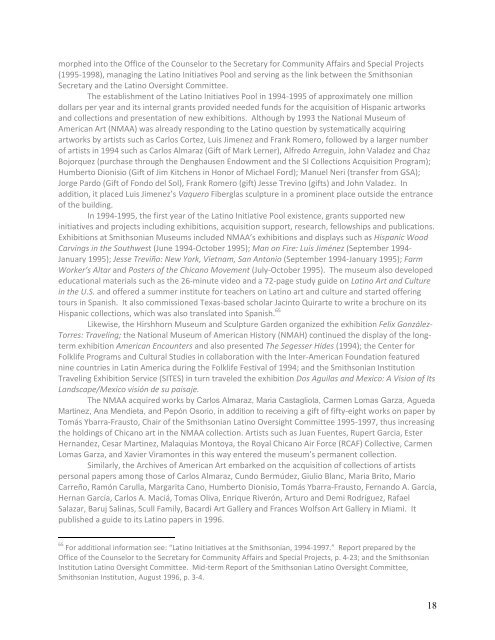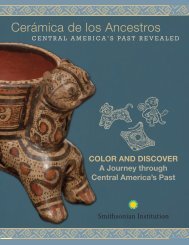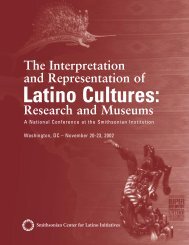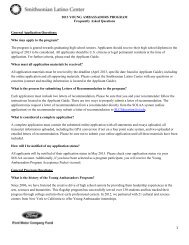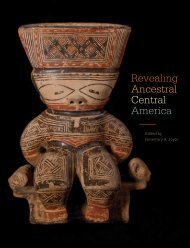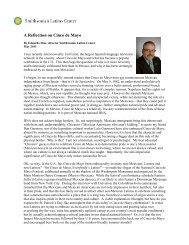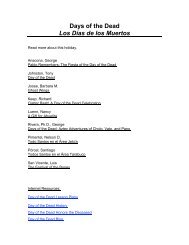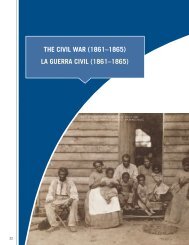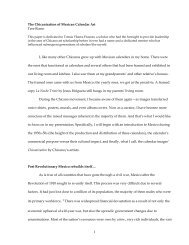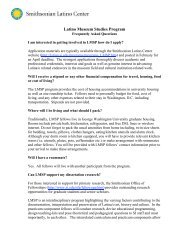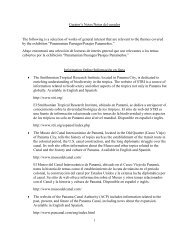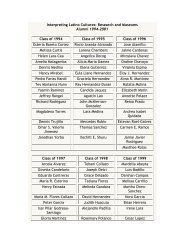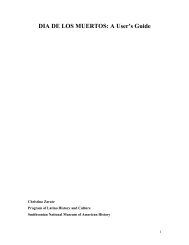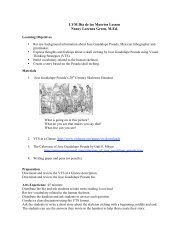smithsonian latino art collections - Smithsonian Latino Center
smithsonian latino art collections - Smithsonian Latino Center
smithsonian latino art collections - Smithsonian Latino Center
Create successful ePaper yourself
Turn your PDF publications into a flip-book with our unique Google optimized e-Paper software.
morphed into the Office of the Counselor to the Secretary for Community Affairs and Special Projects<br />
(1995-1998), managing the <strong>Latino</strong> Initiatives Pool and serving as the link between the <strong>Smithsonian</strong><br />
Secretary and the <strong>Latino</strong> Oversight Committee.<br />
The establishment of the <strong>Latino</strong> Initiatives Pool in 1994-1995 of approximately one million<br />
dollars per year and its internal grants provided needed funds for the acquisition of Hispanic <strong>art</strong>works<br />
and <strong>collections</strong> and presentation of new exhibitions. Although by 1993 the National Museum of<br />
American Art (NMAA) was already responding to the <strong>Latino</strong> question by systematically acquiring<br />
<strong>art</strong>works by <strong>art</strong>ists such as Carlos Cortez, Luis Jimenez and Frank Romero, followed by a larger number<br />
of <strong>art</strong>ists in 1994 such as Carlos Almaraz (Gift of Mark Lerner), Alfredo Arreguin, John Valadez and Chaz<br />
Bojorquez (purchase through the Denghausen Endowment and the SI Collections Acquisition Program);<br />
Humberto Dionisio (Gift of Jim Kitchens in Honor of Michael Ford); Manuel Neri (transfer from GSA);<br />
Jorge Pardo (Gift of Fondo del Sol), Frank Romero (gift) Jesse Trevino (gifts) and John Valadez. In<br />
addition, it placed Luis Jimenez’s Vaquero Fiberglas sculpture in a prominent place outside the entrance<br />
of the building.<br />
In 1994-1995, the first year of the <strong>Latino</strong> Initiative Pool existence, grants supported new<br />
initiatives and projects including exhibitions, acquisition support, research, fellowships and publications.<br />
Exhibitions at <strong>Smithsonian</strong> Museums included NMAA’s exhibitions and displays such as Hispanic Wood<br />
Carvings in the Southwest (June 1994-October 1995); Man on Fire: Luis Jiménez (September 1994-<br />
January 1995); Jesse Treviño: New York, Vietnam, San Antonio (September 1994-January 1995); Farm<br />
Worker’s Altar and Posters of the Chicano Movement (July-October 1995). The museum also developed<br />
educational materials such as the 26-minute video and a 72-page study guide on <strong>Latino</strong> Art and Culture<br />
in the U.S. and offered a summer institute for teachers on <strong>Latino</strong> <strong>art</strong> and culture and st<strong>art</strong>ed offering<br />
tours in Spanish. It also commissioned Texas-based scholar Jacinto Quir<strong>art</strong>e to write a brochure on its<br />
Hispanic <strong>collections</strong>, which was also translated into Spanish. 65<br />
Likewise, the Hirshhorn Museum and Sculpture Garden organized the exhibition Felix González-<br />
Torres: Traveling; the National Museum of American History (NMAH) continued the display of the longterm<br />
exhibition American Encounters and also presented The Segesser Hides (1994); the <strong>Center</strong> for<br />
Folklife Programs and Cultural Studies in collaboration with the Inter-American Foundation featured<br />
nine countries in Latin America during the Folklife Festival of 1994; and the <strong>Smithsonian</strong> Institution<br />
Traveling Exhibition Service (SITES) in turn traveled the exhibition Dos Aguilas and Mexico: A Vision of Its<br />
Landscape/Mexico visión de su paisaje.<br />
The NMAA acquired works by Carlos Almaraz, Maria Castagliola, Carmen Lomas Garza, Agueda<br />
M<strong>art</strong>inez, Ana Mendieta, and Pepón Osorio, in addition to receiving a gift of fifty-eight works on paper by<br />
Tomás Ybarra-Frausto, Chair of the <strong>Smithsonian</strong> <strong>Latino</strong> Oversight Committee 1995-1997, thus increasing<br />
the holdings of Chicano <strong>art</strong> in the NMAA collection. Artists such as Juan Fuentes, Rupert Garcia, Ester<br />
Hernandez, Cesar M<strong>art</strong>inez, Malaquias Montoya, the Royal Chicano Air Force (RCAF) Collective, Carmen<br />
Lomas Garza, and Xavier Viramontes in this way entered the museum’s permanent collection.<br />
Similarly, the Archives of American Art embarked on the acquisition of <strong>collections</strong> of <strong>art</strong>ists<br />
personal papers among those of Carlos Almaraz, Cundo Bermúdez, Giulio Blanc, Maria Brito, Mario<br />
Carreño, Ramón Carulla, Margarita Cano, Humberto Dionisio, Tomás Ybarra-Frausto, Fernando A. García,<br />
Hernan García, Carlos A. Maciá, Tomas Oliva, Enrique Riverón, Arturo and Demi Rodríguez, Rafael<br />
Salazar, Baruj Salinas, Scull Family, Bacardi Art Gallery and Frances Wolfson Art Gallery in Miami. It<br />
published a guide to its <strong>Latino</strong> papers in 1996.<br />
65 For additional information see: “<strong>Latino</strong> Initiatives at the <strong>Smithsonian</strong>, 1994-1997.” Report prepared by the<br />
Office of the Counselor to the Secretary for Community Affairs and Special Projects, p. 4-23; and the <strong>Smithsonian</strong><br />
Institution <strong>Latino</strong> Oversight Committee. Mid-term Report of the <strong>Smithsonian</strong> <strong>Latino</strong> Oversight Committee,<br />
<strong>Smithsonian</strong> Institution, August 1996, p. 3-4.<br />
18


